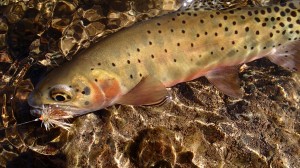Climate change has been a hot topic the last few years and it’s about to heat up once again. The Colorado Climate Change report states that Colorado is warming up. But how will air temperature affect the water quality and fishing in Colorado? The report was done for the Colorado Water Conservation Board, Western Water Assessment, Cooperative Institute for Research in Environmental sciences and the University of Colorado at Boulder with funding from a grant the NOAA Climate Program Office.
Temperatures have been rising over the last 30 years due to increasing concentrations of greenhouse gases in the atmosphere. These changes in the atmosphere and temperature are affecting the water supply in Colorado and its basins.
With the increase in temperature in the entire region, the snow packs will begin to melt one to three weeks earlier in the year than normal. This will result in lower flow periods later in the summer due to the shift in peak periods. Although the runoff will occur earlier, there is less certainty that the amount of runoff will change.
With the change in flows, the procedures of reservoirs and draining may be changed to counter the lower periods of flow. Reservoirs will be forced to keep flows downstream, therefore changing the flood control and water storage operations.
 With a lower water supply and higher temperatures, the amount of water needed for crops will increase, consequently reducing the amount of stream flow. According to the Colorado Climate Report, “Warming temperatures could increase the loss of water from plants and soil, lengthen growing seasons, and increase overall water demand.”
With a lower water supply and higher temperatures, the amount of water needed for crops will increase, consequently reducing the amount of stream flow. According to the Colorado Climate Report, “Warming temperatures could increase the loss of water from plants and soil, lengthen growing seasons, and increase overall water demand.”
The ground water available for agriculture will also be depleted and the recharge rate will decrease due to lower amounts of precipitation every year. If the groundwater is used too much and is unable to recharge in time, more water will be used from the rivers, resulting in even lower stream flows.
These higher temperatures will also affect the quality of the ecosystems. The warmer temperatures will lead to warmer water temperature, resulting in spreading of invasive species. Particularly the spreading into higher mountain streams.
The patterns of fish and other aquatic species will change with the increasing water temperatures. This will lead to a difference in fishing throughout the state. Rainbow trout prefer a water temperature between 55 and 60 degrees Fahrenheit; the change in temperature will force the fish to adjust accordingly. The spawning times will change and the fish would move into higher mountain streams where the water may be cooler.
For more information, read the Colorado Climate Report or the Executive Summary version of the report.










